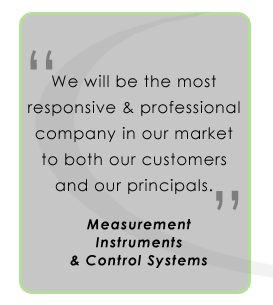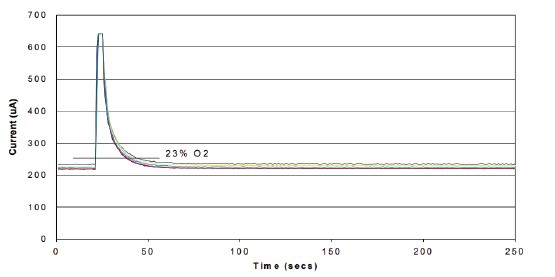|
PRESSURE PULSES CAN CAUSE FALSE ALARMS
TO O2 SENSORS September 2023,
MARIETTA, GA ~
Oxygen Sensors are sensitive to pressure: The output from partial pressure sensors is 100%
proportional to the ambient pressure; therefore, changes
in atmospheric pressure can produce false alarms. For
example, if the pressure increased by 15 kPa (i.e. 15%
increase at an ambient pressure of 1 atmosphere) then
the oxygen sensor output will increase by 15%: from
20.9% to 24% oxygen, causing the gas detector to
alarm.
The output from mass flow-controlled sensors (including
the most of our oxygen sensors) are not 100%
proportional to the ambient pressure, showing a much
reduced pressure effect: about 7% dependent; for
example, a 15 kPa pressure change (i.e. 15% pressure
increase) will cause the sensor output to increase by
7% of 15%: a 1.05% output increase from 20.9 to 21.1%
oxygen, avoiding an alarm. However, mass flow oxygen
sensors show transient behavior when subjected to a
rapid change in ambient pressure.
Rapid pressure changes can occur in several situations:
• If a portable safety instrument is
placed in the trunk of the car and the
lid is closed then the instrument will
see a temporary positive pressure
change.
• If a miner descends rapidly into a
deep mine, the gas detector will see
a rapid positive pressure pulse.
• If a technician or operator passes
through an airlock then the gas
detector will respond to a positive or negative
pressure pulse.
• Hand aspirated or pumped samplers cause positive or
negative pressure pulses.
Although mass flow controlled oxygen sensors show
transient behavior due to pressure pulses, good design
and validation of the pressure pulse effect can minimize
this problem.
Positive and Negative Pressures: A positive change in pressure leads to an almost instantaneous
increase in the output from the oxygen sensor, decaying in
a shape reminiscent of discharge of a capacitor. Negative
pulses also show the same characteristic but are much smaller
in magnitude and most alarms occur from positive pressure
pulses. Characteristics of a Positive Pressure Pulse: A positive pressure pulse can be characterized by two
parameters:
• Pulse peak height
• Time spent above 23% oxygen, which is a typical alarm level;
this parameter assists designers in defining permissible time
windows for ignoring pressure pulses. This time is specified for
near-instantaneous pressure changes, but some applications
create a ramped pressure step, such as a descent into a coal
mine.
• Time spent above 23% oxygen, which is a typical alarm level;
this parameter assists designers in defining permissible time
windows for ignoring pressure pulses. This time is specified for
near-instantaneous pressure changes, but some applications
create a ramped pressure step, such as a descent into a coal
mine. Oxygen Sensors
and Transient Pressure Behavior:
These characteristics listed
below can help customers to design the system to minimize alarms due to pressure
changes.
1. Peak height is linearly
dependent on the magnitude of the pressure change, for pressure pulses or steps
up to 2 bar. Above 2 bar, peak height sensitivity is reduced.
2. Pressure changes less than
2kPa can be ignored.
3. The time in alarm (i.e., a
reading greater than 23% oxygen) increases linearly with the magnitude of the
pressure change.
4. Positive pressure changes
cause peaks that have a peak height typically three times greater than troughs
from negative pressure changes.
5. You should quantify the
magnitude and rate of pressure changes for your applications in order to
determine alarm time windows and expected peak heights.
6. Pressure changes are
usually very fast (except for descents into mines) - much faster than any
expected change in oxygen concentration. This allows software intervention to
determine whether a sensor output transient is due to a true oxygen change or a
pressure change.
7. Sensors with higher output
are less sensitive to pressure changes: the O2-A1 has the smallest peak height
and the O2-A3 has the largest peak height.
To learn more
about the RC Systems
click here
|




